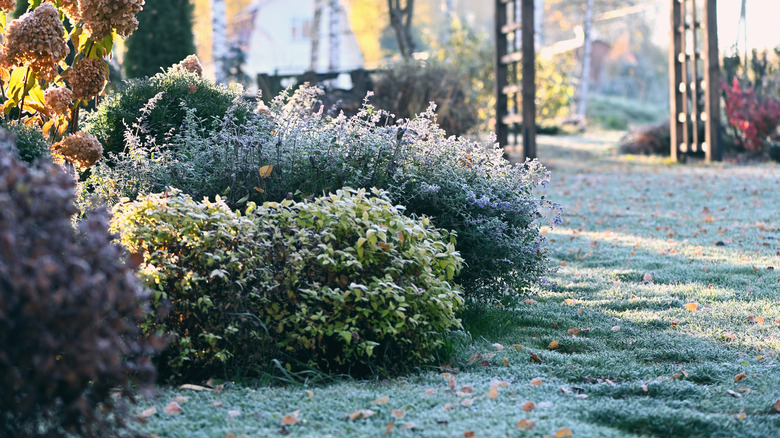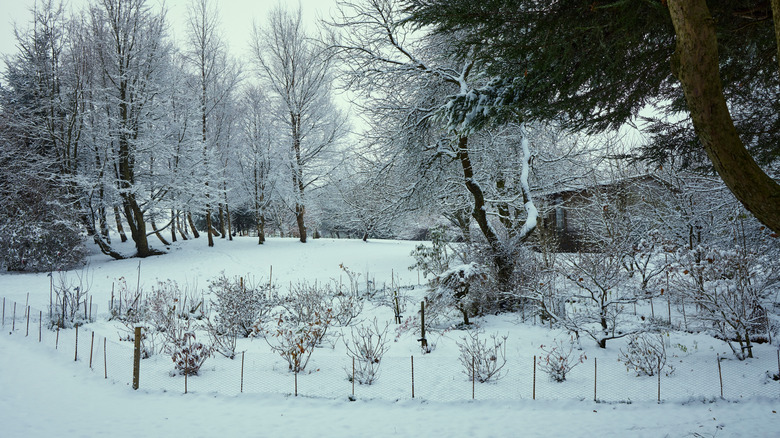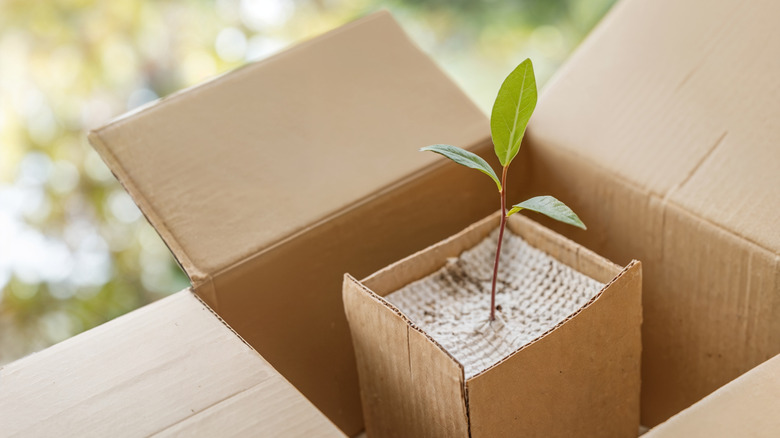How To Care For Dormant Plants In The Winter (And Mistakes To Avoid)
Caring for the garden in winter, especially in colder growing zones, is usually not a labor-intensive task. The garden is at rest, and most of the clean-up work has been done in the fall before plants go to sleep for the winter. However, there are a few things to keep in mind even after putting the garden to bed. We've gathered some tips for caring for dormant plants in the winter garden, as well as some mistakes to avoid, to ensure all will be well when the spring comes around.
If autumn is particularly dry in your area, water your perennial beds, shrubs, and small trees lightly once per week so the ground doesn't freeze when the soil is bone dry. Also, refreshing your garden mulch during this time of year offers good protection from frost heaving and cold damage. Perennials in flower beds should get a two-inch layer of lightweight mulch (like pine straw or shredded pine bark) around their roots after the first hard frost. If a heavy snowfall occurs, gently shake the snow from shrubs to prevent branches breaking. If you have young fruit trees, wrap them in burlap to keep hungry wildlife from nibbling the bark or young buds.
If you have perennial plants in your vegetable garden, these also go dormant in winter. Cut back perennial herbs like oregano, chives, lavender, and thyme, leaving 4 to 6 inches of growth visible. In USDA Hardiness zones 3 through 5, after the ground freezes, put down a couple of inches of shredded bark mulch to protect the roots from frost heaving. This same method works well for other perennial vegetables like rhubarb.
Be cautious about pruning, moisture, and nearby ice management
Most perennial plants that go dormant in winter are good at surviving on their own through the cold season, but there are still things to avoid doing to make sure perennials stay alive until the spring thaw. Any late-season pruning should be done at the proper time. Avoid pruning between mid-autumn and winter to protect against damage in frigid weather. Pruning can stimulate growth, and this can make some plants, like fruit trees, vulnerable to freezing temperatures. For this reason, some gardeners wait to prune until late winter after several hard frosts have occurred but before new growth emerges.
Another thing to avoid is mulching too heavily. Although experts recommends lightly mulching to prevent frost heaving and insulate the plants' roots, too much mulch can cause problems. Adding mulch that absorbs too much moisture can cause roots to rot if they're trapped under snow during spring thaw. To prevent this, use a lightweight mulch material such as pine straw, and keep your mulch layer around 1 to 2 inches deep.
You'll also need to avoid using salt near the roots of your perennials. If you use salt to melt ice on your driveway or sidewalk, be aware that the salty runoff produced when the ice melts can damage the roots of your plants and may kill them. The best way to prevent this is by keeping salt away from your plants (sand can be better to melt ice for winter driveway safety) and not planting shrubs or perennials too close to surfaces that freeze in winter.
Caring for dormant plants before spring planting
If you're like many avid gardeners, you may purchase plants for spring planting via mail order. These plants are usually shipped in their dormant state, either as bare roots or tubers, or in small containers with potting medium. Sometimes these plants arrive at the perfect time for planting, but planting might need to be delayed if the soil is still frozen or too wet, for example. If you need to wait to plant these new perennials, there are a few care tips to keep in mind.
Most plant sellers will include some instructions for caring for dormant plants on arrival. The first thing to do is open the box and give the plants some air. Some plants may have a plastic bag tied around them for stability, and this should also be removed to allow air circulation. If the plants are in pots with soil, place them in a setting with appropriate light, and water them lightly. If they are "bare root" plants wrapped in plastic, loosen the plastic to give them air. Keep them out of the sun, and if they're wrapped in paper, moisten the paper slightly.
Most plants are shipped at the proper planting time for your growing zone, and will gradually break their dormancy as spring arrives, so do plant these arrivals as soon as you can manage it. Keep an eye on the weather to avoid planting before an intense weather event, like heavy rain or snow, high winds, or a sudden drop in temperature.


